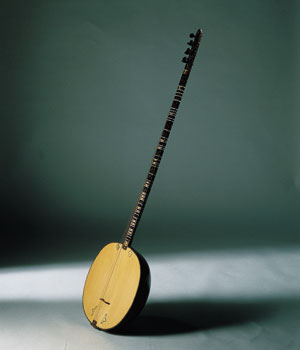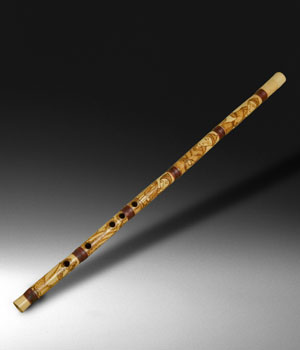EBOOK
Traditional Instruments
The instruments used most frequently in Persian traditional music are: santur, setar, kamancheh, ghichak, ney, zarb and dayereh. Ghichak and dayareh, along with other well-known instruments such as surna, balaban, tambur, dotar, retab and dohol, are more commonly associated with folk music. The evolved and developed forms of these instruments are found all over the world. The barbat, which became the oud (al oud in Arabic), for instance, became the European lute, the name itself reflecting its ancestry.
Zarb
This is a single-headed drum whose wooden body is chiseled from a single piece of hardwood. The wood is usually painted, then a wet goatskin is stretched over the open end and glued and strung around the rim. It is played with fingers of both hands; the right hand is used for deep sounds in the center, while the left hand concentrates on high sounds near the rim and snaps.

Tar
A six-stringed, plucked instrument with a skin-covered soundbox. These six strings are tuned in pairs, the high-pitched and central pairs in unison and the bottom pair in octave. Originally there were only five strings. The sixth was added by Darvish Khan and is called the Mostaq string. Adjustable string frets are tied around the long-neck, giving a scale that includes the twelve western notes plus several semi- or quarter tones. Of course, all the notes are never used in a mode, but seven or eight pitches are chosen from among seventeen possibilities. A small brass plectrum, or mezrab, inserted in a lump of wax is held in the right hand. The fourth finger of the left hand is also used to pluck the strings for ornaments. Notes may be raised or ornamented by sliding the strings over the frets with a sort of squeezing motion of the left hand. The tar has a sister form in the Afghan rebab, also an ancient Persian instrument, and in the Indian sarod, which isa descendent of the rebab. Skin-covered instruments have also been common to Turko-Mongol peoples for centuries.

Dayereh
A circular wood frame covered on one side with skin. It is played with the fingers of both hands and the instrument is held vertically with the palms facing the player.

Tanbur
A long-necked, plucked instrument with adjustable frets. The eight strings are grouped in pairs tuned A, C, D, D; the two low strings are made of brass and the others of steel. Although the instrument in normally played with a plectrum, a bow can be used as well. A twang or vibrato effect can be achieved by slightly twisting the instrument after a note is played.

Sorna
A type of oboe usually accompanied by the dohol, or two-headed, horizontally-played barrel drum. These two instruments are used as accompaniment for folk dancing, weddings, competition, and festivals. The name sorna is defined etymologically by some as sur-ney (festival flute).

Setar
The setar is a long-necked, four stringed instrument which has a soundbox covered with thin wood. It is a descendent of the ancient Iranian tambur of Khorasan, which is credited with being the ancestral form of nearly all lutes now known in the East. The setar originally had only three strings. The fourth was added by the great mystic Moshtaq Ali Shah. The setar itself is more adaptable to spiritual music. The left-hand technique for playing the setar is nearly identical to the tar techinque, but, instead of a plectrum, the fingernail of the right-hand index finger is used. This technique for playing, as well as many other aspects of the Persian setar, including the shape of the instrument and the peg arrangement, were adopted in India and resulted in the Indian sitar.
Santur
Literally meaning “hundred strings,” this instrument has had a long and prestigious history, and in its many avatars is an important instrument throughout the musical world.
The Persian version is a trapezoid-shaped wooden-box made of aged walnut with strings passing from one end to the other over small bridges. There are two types of strings used: the steel strings which pass over the bridges at the left are the high notes and the brass strings which pass over the bridges at the right are the low notes. Each note is produced by striking a set of four strings which are tuned in unison. There are nine sets of strings of each metal on each side. The sets are divided by adjustable bridges altogether. The wires are hit by two thin hardwood mallets called Mezrabs, held between the thumb, index and middle fingers, and manipulated by the controlled wrist movement.
Oud
A short-necked lute with a large, round soundbox. The earliest example of an oud-type lute, called barbat by the ancient Persians, is found depicted in excavations from Tell at Susa from the eighth century B.C. Later, the same instrument appears in East Turkestan in a Ghandahar fresco of the fifth to seventh century A.D., in which the instument is shown with four or five strings. In Mafatih al Ulum, an Arab encyclopedia of tenth century A.D., the Persian barabt is said to have been so named because of its resemblance to the breast of a duck.
From Persia, the barbat moved east to China, where, before the Chou dynasty, only the zither (chin) was known. It was during the Han dynasty, when Chinese power and influence stretched to the Caspian Sea, the Western stringed instruments were brought to the East through the court orchestras of such countries as India, Tibet, and Mongolia and cities like Samarkand, Bukhara, and Kashgar. Sources claim that central Asian nomads found the Indo-Iranian instrument convenient for playing on horseback and thus carried it with them from the West to the East.
The Chinese renamed the barbat the pipa, the Koreans soon adopted it and called it hwang bipa, and the Japanese named it biwa. The earliest archaeological evidence of the lute family in China consists of sculptures of the sixth century A.D. From 623 A.D. the Japanese sculptures show the lute. Beautiful lutes of sandalwood with mother-of-pearl and tortoise-shell work dating from 749 A.D. are still in the Imperial Treasury at Nara, Japan. Althoughh an early Asian gold painting depicts the four-stringed lute played with a large plectrum (called bahi by the Japanese today), the Chinese pipa is currently plucked with the fingers like flamenco guitar.
Variants of the Chinese pipa are the yueh chin (moon guitar) and the san hsien. The yueh chin is a short-necked lute attributed to the Tsin dynasty (265-419 A.D.). An eighth century inlaid specimen with the frets on the neck and on the soundboard is in the treasury at Nara and is depicted on the Turkistan fresco of 500 A.D. This instrument is obviously developed from the older form. The san hsien is the ancestor of the Japanese shamisen.
One of the earliest mentions of the Arabo-Persian oud in Europe was in the Roman de la Rose. Many fourteenth century art works depict the instrument with four strings and played with a quill plectrum. By the middle of the fourteenth century, the four strings had evolved to four courses or pairs of strings as had already happened in the Islamic world. By the fifteenth century, the tuning developed from the Arab tuning in fourths with a treble G to the odd D, A, F, C system and the plectrum was discarded in favor of the finger-plucking technique.
The earliest lute books were in Italian, and from these texts it is obvious that the art of lute-playing in Europe, although far inferior to the Arabo-Persian virtuosity, was still relatively highly developed. In Spain, the vihuela or de mano was used, although the odd European lute tuning was adopted.
The guitar was innovation on the basic lute form. The cittern tuning remained more faithful to the ancentral form and is cited as being E, D, G, A (D). Also, making a flat instrument was probably easier than gluing steam-bent strips together in a pear shape for Europeans who did not seem to take much pride in painstaking craftsmanship as Moslems did. Thus, the guitar with its illogical tuning and tinny-noted soundbox was a step down from the noble oud.
The Italian mandolin is a smaller version of Arab oud, the main deviation being that the strings continue past the bridge to the end of the soundbox instead of beginning at the bridge as in the case of oud.
The Russian balalaika, with its three strings and triangular soundbox, might not at first appear to be in the oud family, but it is just another deviation from the original pear shape. On the other hand, the buzuki of Greece and neighboring Balkan countries has faithfully maintained the original pear shape of the oud, and the Romanian cobza retains the logical Eastern tuning of the D, A, D, G in octave.
The most far-removed descendent of the oud is the Russian bandoura, which, as well as having several melody strings, has a large group of zither-type auxiliary strings. The bandoura could be considered a combination of oud and zither.
The American banjo has African origins, its skill-covered soundbox resembling that of the Ethiopian lyre, but its guitar playing concepts relate it also to the oud.

Ney

Ghichak

